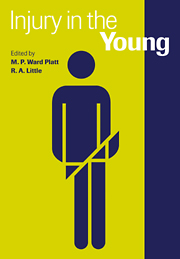Book contents
- Frontmatter
- Contents
- List of contributors
- Editors' Preface
- 1 The epidemiology of trauma involving children
- 2 Emergency room requirements for children
- 3 Child deaths in Accident and Emergency
- 4 Immediate life support
- 5 Evaluation of injury in children
- 6 Injuries of the developing brain
- 7 Wound healing in children
- 8 The lung after injury in children
- 9 Metabolic and endocrine stress responses to surgery
- 10 Head injury in children
- 11 Near drowning
- 12 The acute response to burn injury in children
- 13 Nutritional support of the severely burned child
- 14 Recovery, rehabilitation and the neuropsychological sequelae of head injury
- 15 Children's rights and child protection
- Index
6 - Injuries of the developing brain
Published online by Cambridge University Press: 18 September 2009
- Frontmatter
- Contents
- List of contributors
- Editors' Preface
- 1 The epidemiology of trauma involving children
- 2 Emergency room requirements for children
- 3 Child deaths in Accident and Emergency
- 4 Immediate life support
- 5 Evaluation of injury in children
- 6 Injuries of the developing brain
- 7 Wound healing in children
- 8 The lung after injury in children
- 9 Metabolic and endocrine stress responses to surgery
- 10 Head injury in children
- 11 Near drowning
- 12 The acute response to burn injury in children
- 13 Nutritional support of the severely burned child
- 14 Recovery, rehabilitation and the neuropsychological sequelae of head injury
- 15 Children's rights and child protection
- Index
Summary
Introduction
‘Brain injury’ is a term commonly used and accepted to mean that the cerebrum has been damaged by being exposed to severe mechanical forces which are sufficiently powerful to fracture the skull and/or harm the brain by subjecting it to violent, disruptive movements. The immediate or primary effects of such an injury can be to tear the surface of the brain, disrupt the white fibre tracts within the substance of the brain, rupture blood vessels or cause them to go into spasm together with other less easily identifiable consequences, such as interruption of normal transmission across synapses. The immediate effects of a head injury are often followed by delayed or secondary ones which are potentially as damaging. Blood vessels running through channels in the skull and on the outer surface of the dura may be torn and bleed to give rise, several hours later, to an extradural haematoma. Rupture of vessels running on the surface of the brain, both arteries and veins, can produce subdural haematomas which take time to develop. Tearing of vessels within the brain parenchyma can give rise some time later to intracerebral haematomas which can vary in size from tiny petechial haemorrhages to large blood clots. Haemorrhages close to the ventricles may burst into their cavities causing an intraventricular haemorrhage which can later lead to hydrocephalus if an obstruction of the ventricular system or subarachnoid spaces supervenes. Disruption or spasm of the larger cerebral arteries can lead to infarction of the territories they supply.
- Type
- Chapter
- Information
- Injury in the Young , pp. 74 - 97Publisher: Cambridge University PressPrint publication year: 1998



